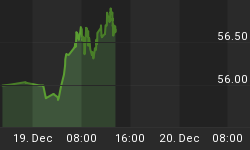I'm sure we'll read every possible analysis about the "imminent" rate cut on the benchmark Fed Fund's Rate before (and possibly even more after) the next FOMC meeting. As a technician, I'm really apathetic about this speculative obsession. Trading on guessing what the FOMC will do has very little, if anything, to do with the study of probability based on statistical data. Money would probably be better spent, and enjoyably so, in Vegas. And, as a fundamentalist, I don't believe the rate cut is going to solve the real problems anyway. There's no need to dispense my resources jut to go through this exercise in futility.
One useful exercise that I go through faithfully, however, is keep track of money in the hands of the public, a.k.a the M1 Money Supply. Since the housing market top in the 2nd half of 2005, the 52-week ROC (Rate of Change), or the year-over-year change, of M1 had started to dip into the negative territory (see Chart 1). And, since the beginning of this year, the ROC had begun to fall below minus 2% (blue circle). Overall, it's been oscillating with greater volatility (higher up-and-down fluctuations from week to week) around 0% (no change) for almost 2 years. I've looked through past 26 years worth of data, and I've seen nothing like this. I'm concerned this unprecedented pattern may be foreshadowing more serious problem ahead.

Chart 1
Longer term chart shows that past recessions had correlated closely with the descend of the M1 52-week ROC into the negative territory (red down arrows on Chart 2 below). There's no mystery in this correlation. When the public has no money to consume, 70% of our economy have no place to go but down. Incidentally, the public also used to be known as the Citizens but is now better known as American Consumers. More on that in Lynne Twist's book, Unleashing the Soul of Money.

Chart 2
What's more of a mystery is that this is happening right in the face of the Fed's relentless liquidity infusion. Other than a brief pause in the summer of 2006, the 52-week ROC of M2 has been in a strong uptrend (Chart 3). I've shown you before that the correlation coefficient between M2 and M3 is 0.9999, which simply means that tracking the movement of M2 is just as good and as reliable as tracking the movement of M3, the aggregate money supply.

Chart 3
And, if I took out M1 from M2, the absolute increase of M2 is even more prominent (Chart 4).

Chart 4
One thing the dichotomy of M1 and M2 tells us is that the liquidity increase has almost nothing to do with the public's input. Another thing is that the liquidity injection hasn't put any more money into the hands of the public. But that wasn't the Banking Cartel's intent anyway; the intent was merely to bail out Wall Street. The problem is that all the monetary manipulations may ultimately make the condition even worse for the public. And, that's the real problem even the Fed's rate cut won't be able to solve.
Have a nice Labor Day weekend! I'll see you later next week.















